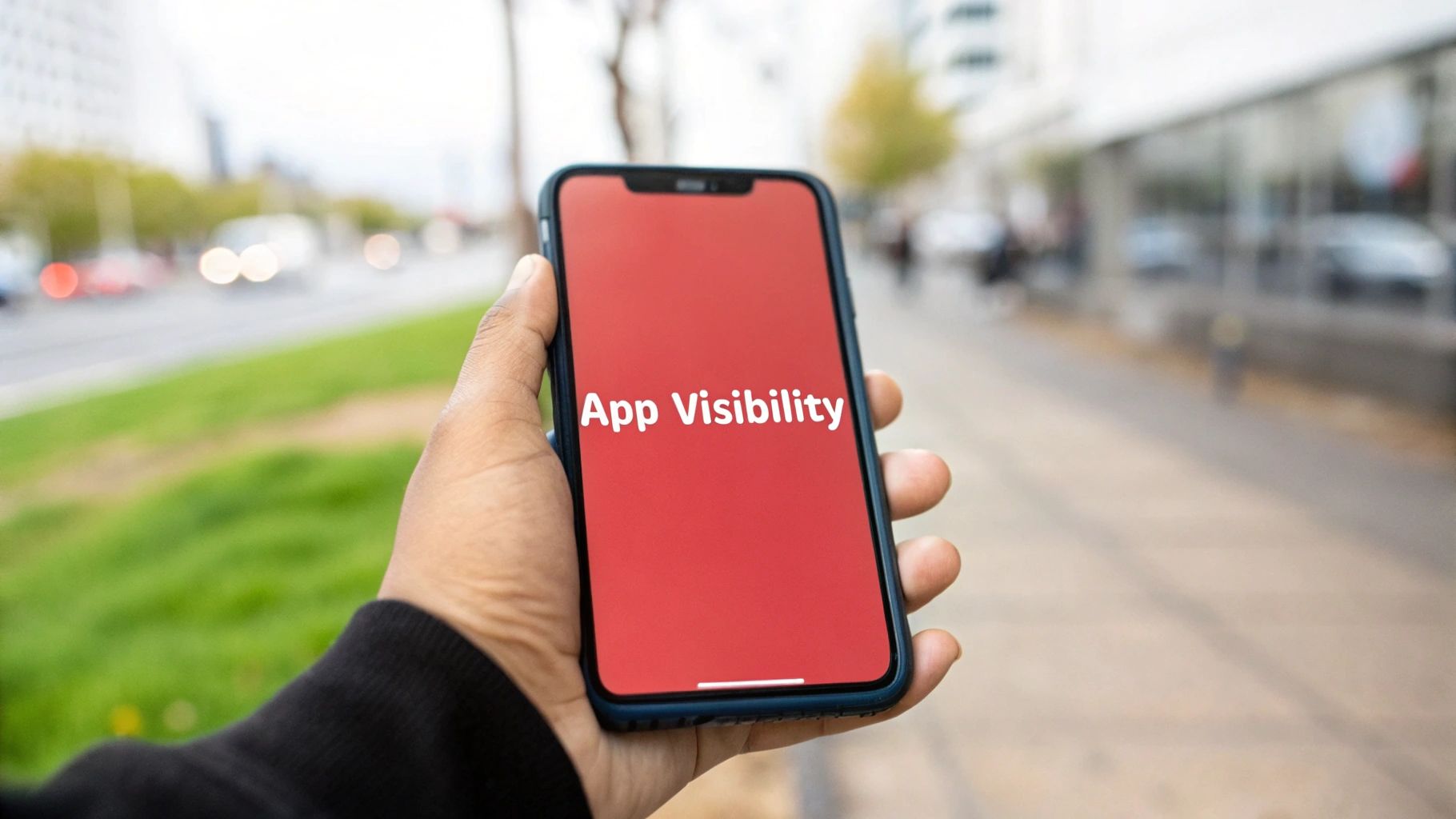10 Effective Mobile App Marketing Strategies for 2025
In the crowded digital marketplace launching a mobile app is only the first step. The real challenge lies in cutting through the noise to attract engage and retain a loyal user base. Simply having a great product is not enough; a robust and multi-faceted plan is essential for survival and success. Many developers focus intensely on creation but falter when it comes to promotion, leading to low visibility and disappointing download numbers. This guide demystifies the process by presenting ten proven mobile app marketing strategies that cover the entire user lifecycle, from initial discovery to long-term loyalty.
This comprehensive listicle is designed to be a practical toolkit. We will move beyond theory and provide actionable insights into a range of essential tactics, including App Store Optimisation (ASO), influencer marketing, paid user acquisition and powerful re-engagement campaigns. You will learn not only what to do but how to implement these strategies effectively, with real-world examples to illustrate their impact.
Whether you are launching a new app or looking to revitalise an existing one, these insights will provide a clear roadmap to achieving sustainable growth. As a UK digital marketing agency, we have seen first-hand how a strategic approach can transform an app's trajectory, particularly in competitive sectors like motorsport and automotive. Let us explore the techniques that will make your app stand out and thrive, helping you connect with the right audience and build a foundation for long-term success.
1. App Store Optimisation (ASO)
App Store Optimisation (ASO) is the foundational process of enhancing a mobile app's visibility within app stores like the Apple App Store and Google Play Store. Often called the "SEO for apps," it's one of the most crucial mobile app marketing strategies for driving organic, high-quality downloads. The core goal is to rank higher in search results for relevant keywords and to increase the conversion rate from a store listing visit to a successful installation.

This is achieved by methodically optimising various on-page elements (app title, keywords, description) and off-page factors (ratings, reviews, download velocity). A well-executed ASO strategy ensures your app is discovered by its target audience at the very moment they are searching for a solution you provide. This makes it a highly cost-effective and sustainable method for user acquisition.
How to Implement ASO Effectively
Implementing ASO is an ongoing cycle of research, optimisation and analysis. Success stories like Headspace, which reportedly increased its downloads by 40% through targeted ASO, highlight the power of this discipline.
Here are actionable tips to get started:
- Keyword Research: Identify and target long-tail keywords (e.g. "guided meditation for sleep") that have high relevance but lower competition. Use tools like Sensor Tower to analyse keyword volume and difficulty.
- Creative Asset Optimisation: Your app icon, screenshots and preview video are your digital storefront. Bumble famously improved its conversion rate by 25% by testing and optimising its screenshots to better communicate its value proposition.
- Encourage Reviews: Positive ratings and reviews are powerful social proof and a key ranking factor. Integrate a non-intrusive prompt in your app to ask satisfied users for feedback after they have achieved a positive milestone.
- Localise Your Listing: Adapt your app's metadata (text and visuals) for different languages and cultures. This simple step can unlock significant growth in international markets.
By consistently refining these elements you create a powerful flywheel effect. Higher rankings lead to more downloads and positive reviews further boost your rankings, solidifying your app's position in a competitive marketplace.
2. Influencer Marketing
Influencer marketing leverages social media personalities and content creators to promote mobile apps to their engaged and often niche audiences. This strategy capitalises on the trust and authenticity that influencers have built with their followers, making it one of the most effective mobile app marketing strategies for driving app awareness, downloads and user engagement. The core goal is to tap into a pre-existing community and receive a credible endorsement from a voice that the target market already respects.

This is achieved by collaborating with creators whose content and audience align perfectly with the app’s purpose. Unlike traditional advertising, influencer marketing feels more like a genuine recommendation from a trusted friend. A well-organised campaign can generate immediate results and create authentic user-generated content that can be repurposed across other marketing channels, providing long-term value.
How to Implement Influencer Marketing Effectively
Implementing influencer marketing requires careful planning, from selection to campaign analysis. The explosive growth of TikTok was significantly accelerated by its early adoption of influencer partnerships, turning creators into brand evangelists. Similarly, the meditation app Calm collaborated with celebrities like Matthew McConaughey to lend star power and credibility to their brand.
Here are actionable tips to get started:
- Select the Right Influencers: Choose influencers whose audience perfectly matches your target demographic. Focus on their engagement rates and audience sentiment rather than just follower counts. Micro-influencers often deliver higher engagement and a better return on investment.
- Grant Creative Freedom: While providing clear brand guidelines is essential, allow influencers the creative freedom to present your app in their own authentic voice. This ensures the promotion feels natural and resonates with their followers.
- Track Performance Accurately: Use unique promo codes, custom landing pages and trackable download links for each influencer. This allows you to measure the direct impact of each collaboration and calculate your ROI precisely.
- Focus on Long-Term Partnerships: Building lasting relationships with key influencers can turn them into genuine brand advocates. This is more powerful than one-off promotions and fosters deeper audience trust. Unlocking the potential of influencer marketing requires a strategic approach.
By carefully integrating influencers into your marketing mix you can cut through the noise of a crowded app marketplace. Their endorsement provides powerful social proof and drives high-intent users directly to your app store page, making it a vital component of modern user acquisition.
3. Social Media Marketing
Social Media Marketing leverages platforms like Instagram, TikTok and Twitter to promote a mobile app, build brand awareness and drive installations. It combines organic content creation, paid advertising and community management, making it one of the most versatile mobile app marketing strategies available. The primary goal is to engage with potential users where they spend their time, building a loyal following that translates into downloads and long-term advocacy.

This strategy works by creating content that resonates with a specific target audience, encouraging shares, comments and clicks to the app store page. By establishing a strong brand personality and consistently providing value, social media marketing moves beyond simple promotion. It creates a direct line of communication with users, fostering a community around the app and generating powerful social proof.
How to Implement Social Media Marketing Effectively
A successful social media strategy is dynamic and platform-specific, requiring consistent effort and adaptation. A standout example is Duolingo, which built a massive viral presence on TikTok by using its mascot, Duo the Owl, in humorous, trend-aware videos that perfectly captured the platform's culture and drove brand recognition.
Here are actionable tips to get started:
- Tailor Content to Each Platform: Don't simply cross-post. Adapt your messaging and visuals for the unique audience and format of each network. A professional update on LinkedIn should look very different from a behind-the-scenes Reel on Instagram.
- Utilise Paid Advertising: Leverage the powerful targeting capabilities of social media ads to reach specific demographics, interests and behaviours. Use formats like app install ads that link directly to the App Store or Google Play.
- Engage Authentically: Social media is a two-way conversation. Respond to comments and messages promptly, participate in relevant discussions and monitor social mentions to gather valuable user feedback.
- Embrace Platform-Specific Features: Use features like Instagram Stories, TikTok Duets and live streaming to create timely and interactive content. Spotify’s annual "Wrapped" campaign is a masterclass in creating shareable, user-centric content that generates huge organic buzz.
By integrating these tactics you can transform social media from a simple broadcast channel into a powerful engine for user acquisition and community building, ensuring your app remains relevant and visible.
4. Paid User Acquisition (PUA)
Paid User Acquisition (PUA) involves investing in paid advertising channels to drive app installs and accelerate user growth. Unlike organic strategies this performance-driven approach provides immediate and scalable results by placing your app in front of a highly targeted audience on platforms like Google Ads, Meta (Facebook) Ads, TikTok and specialised mobile ad networks.

The core principle of PUA is to acquire high-value users efficiently by leveraging data analytics and constant optimisation. By carefully managing budgets and tracking performance, marketers can ensure that the cost to acquire a customer (CAC) remains lower than their lifetime value (LTV). This makes PUA an indispensable tool for rapid market entry, scaling growth and outmanoeuvring competitors.
How to Implement PUA Effectively
A successful PUA strategy is built on a foundation of data-driven testing and continuous improvement. For instance, Airbnb has masterfully used targeted Facebook and Google advertising to reach travellers with specific interests and booking intent, significantly fuelling its global expansion.
Here are actionable tips to get started:
- Start Small and Scale: Begin with modest budgets across a few channels to test what works. Once you identify a winning combination of creatives, messaging and audience targeting you can confidently scale your investment for maximum impact.
- Focus on LTV to CAC: The ultimate measure of PUA success is profitability. Prioritise acquiring users who engage with your app and generate revenue, ensuring their lifetime value far exceeds the initial acquisition cost.
- Test Creatives Relentlessly: Your ad creative is crucial. A/B test multiple formats (video, static image, playable ads) and messaging to discover what resonates most with your target audience and drives the highest conversion rates.
- Use Proper Attribution: Employ attribution tools like AppsFlyer or Adjust to accurately track where your installs are coming from. This data is vital for optimising campaigns and allocating your budget effectively. Mobile app marketers must also navigate the evolving landscape of user privacy; explore the significant impact of iOS 14 on digital advertising to understand and adapt your paid acquisition strategies.
5. Content Marketing
Content marketing is a strategic approach that involves creating and distributing valuable, relevant and consistent content to attract and engage a clearly defined audience. For mobile apps, this means moving beyond direct advertising and instead providing genuine value that solves user problems, builds brand authority and naturally introduces the app as the ideal solution. It's one of the most effective mobile app marketing strategies for long-term, organic growth and user loyalty.
This strategy works by establishing your brand as a thought leader and trusted resource in your niche. When potential users find your helpful blog posts, insightful videos or educational resources, they build a positive association with your brand. This makes them significantly more likely to download and engage with your app when they need the solution it provides. This method focuses on building a relationship first, rather than making a direct sales pitch.
How to Implement Content Marketing Effectively
Implementing content marketing requires a deep understanding of your target user's pain points and interests. Success stories like Buffer, which built its user base through its industry-leading social media marketing blog, prove the power of educating your audience. Similarly, the personal finance app Mint attracted millions of users by creating a blog that offered practical money management advice.
Here are actionable tips to get started:
- Solve Real Problems: Create content that directly addresses the challenges and questions your target audience has. This could be in the form of blog posts, how-to guides, video tutorials or templates.
- Optimise for Search: Ensure your content is discoverable by integrating relevant keywords your users are searching for. Use SEO best practices to rank on search engines like Google, driving organic traffic to your resources.
- Repurpose Your Content: Maximise your efforts by repurposing a single piece of content into multiple formats. A detailed blog post can become a video, a series of social media updates, an infographic and a podcast episode.
- Include Clear Calls-to-Action (CTAs): Within your valuable content, strategically place clear and compelling CTAs that guide readers to download your app or visit its landing page.
By consistently delivering value you build an audience that trusts your brand and sees your app as the go-to tool in its category. To delve deeper into modern approaches you can explore more about the evolution of content marketing on superhub.biz.
6. Referral and Viral Marketing
Referral and viral marketing transforms your existing user base into a powerful acquisition engine. This approach leverages word-of-mouth promotion by incentivising satisfied users to share your app with their personal and professional networks. It's one of the most effective mobile app marketing strategies for creating exponential growth, as each new user has the potential to bring in several more, generating a viral loop.
This strategy works by offering a clear value exchange: the existing user (the referrer) and the new user (the referee) both receive a reward for the referral. This creates a powerful, trust-based acquisition channel that often results in highly engaged and loyal users. A well-designed referral programme can dramatically lower your customer acquisition cost while scaling your user base organically.
How to Implement Referral Marketing Effectively
Successful referral marketing is about making sharing both rewarding and effortless. The legendary growth of Dropbox, which offered extra storage space to both the referrer and the new user, proved that a compelling incentive tied directly to the product's core value can fuel massive adoption.
Here are actionable tips to get started:
- Design a Dual-Sided Incentive: Create a clear value proposition for both parties. Uber’s model, which gave a free ride to the new user and account credit to the referrer, is a classic example of a win-win structure that motivates sharing.
- Make Sharing Effortless: Integrate the referral feature seamlessly within your app. Use pre-populated messages and one-click sharing options for social media, email and messaging apps to remove any friction from the process.
- Track Your Viral Coefficient: Measure the number of new users each existing user generates (your K-factor). Continuously test different reward structures and messaging to optimise this metric for maximum viral spread.
- Implement Fraud Prevention: As your programme scales, put measures in place to prevent referral abuse, such as verifying new user accounts or setting limits on rewards to protect your budget and ensure genuine growth.
By systematically building and refining a referral system you can tap into the most authentic marketing channel available: a genuine recommendation from a trusted friend. This builds social proof and drives sustainable, cost-effective growth.
7. Email Marketing
Email marketing remains a powerful and direct communication channel for building lasting relationships with mobile app users. This strategy involves collecting user emails and sending targeted messages to nurture them through their entire lifecycle from pre-launch awareness to long-term retention. It’s one of the most effective mobile app marketing strategies because it provides a direct line to your audience, independent of app store algorithms or social media platform changes.
The core purpose is to deliver value outside the app itself, encouraging downloads, driving engagement and preventing churn. By sending personalised content like onboarding tips, feature announcements or re-engagement campaigns you can keep your app top-of-mind and guide users towards becoming loyal advocates. This owned channel offers a high return on investment and deepens the user connection beyond the confines of the app interface.
How to Implement Email Marketing Effectively
A successful email strategy is built on segmentation, personalisation and value. Duolingo masterfully uses this approach with its famous streak reminder emails which create a sense of urgency and habit, directly boosting daily active users. Similarly, Grammarly's educational emails provide genuine writing tips, subtly leading users towards its premium features.
Here are actionable tips to get started:
- Segment Your Email Lists: Group users based on their in-app behaviour, such as active users, lapsed users or those who have just completed a key action. This allows you to send highly relevant and personalised content.
- Optimise for Mobile: Ensure your subject lines are concise and your email designs are responsive. The majority of users will open your emails on their mobile devices so a seamless experience is crucial.
- Include Clear Calls-to-Action: Every email should have a purpose. Use deep links in your call-to-action buttons to take users directly to a specific screen or feature within your app, reducing friction.
- Provide Value, Don't Just Promote: Your emails should offer more than just sales pitches. Share useful tips, success stories or exclusive content that helps users get more value from your app, like Evernote's productivity guides.
By creating a strategic email marketing programme you build a powerful asset for user communication. This direct channel is invaluable for driving specific actions, gathering feedback and ultimately increasing the lifetime value of your user base.
8. App Review and Rating Management
App Review and Rating Management is the strategic process of monitoring, influencing and responding to user feedback in app stores. This critical component of mobile app marketing strategies directly impacts an app's reputation, conversion rate and even its ranking in store search results. Positive ratings and reviews act as powerful social proof, reassuring potential users of your app's quality and value before they commit to downloading it.
This involves proactively encouraging satisfied users to leave feedback, professionally addressing negative comments and channelling insights back into the development process. By actively managing this dialogue, brands can build trust, improve their product and mitigate the damage from poor reviews. A high star rating is often the first quality indicator a user sees making it a non-negotiable focus for sustainable growth.
How to Implement App Review and Rating Management
Effective management is a continuous cycle of engagement and improvement. For instance, Airbnb's world-class customer service often resolves issues before they become negative reviews while Headspace strategically prompts users for a review after they complete a successful meditation session, capturing them at a moment of satisfaction.
Here are actionable tips to get started:
- Prompt Strategically: Ask for reviews after a user has achieved a positive milestone or completed a key action. Avoid interrupting the user experience and ensure the prompt is non-intrusive.
- Respond to All Reviews: Acknowledge both positive and negative feedback. Thank users for praise and respond to criticism professionally, offering solutions or directing them to support channels. This shows you value your user base.
- Create a Feedback Loop: Treat reviews as a source of invaluable product insight. Systematically analyse feedback to identify common bugs, feature requests and user pain points to inform your development roadmap.
- Analyse Competitor Reviews: Monitor the feedback on competing apps to identify their weaknesses and discover market gaps or features your audience desires.
By making review and rating management a core function you not only improve your app store presence but also foster a loyal community and build a better product based directly on user needs.
9. Partnership and Cross-Promotion
Partnership and cross-promotion strategies involve collaborating with other complementary brands, apps or platforms to tap into their established audiences. This is one of the more powerful mobile app marketing strategies for rapid, scalable growth because it leverages the trust and reach of an existing brand. The core goal is to create a mutually beneficial alliance that introduces your app to a relevant, engaged user base that you might otherwise struggle to reach.
This is achieved by identifying non-competing businesses that share a similar target demographic and creating a joint marketing campaign or product integration. A well-executed partnership can significantly lower user acquisition costs and enhance your brand's credibility through association. It transforms marketing from a solo effort into a collaborative venture, amplifying the results for everyone involved.
How to Implement Partnerships Effectively
Implementing a successful partnership requires strategic planning, clear communication and a focus on mutual value. A classic example is the long-standing collaboration between Nike and Apple, which integrated Nike's fitness tracking capabilities into the Apple Watch, benefiting both brands immensely by appealing to health-conscious tech users.
Here are actionable tips to get started:
- Identify Synergistic Partners: Look for brands or apps that your target audience already uses and trusts. For instance, a travel booking app could partner with an airline or a currency conversion app.
- Establish Clear Goals: Before approaching any potential partner define what success looks like. Is the goal to drive a specific number of downloads, increase brand awareness or boost in-app purchases? Set clear, measurable KPIs.
- Create a Compelling Value Proposition: Your outreach must clearly articulate the benefits for your potential partner. How will the collaboration help them achieve their business objectives? Focus on the "what's in it for them" aspect.
- Start with a Pilot Programme: Instead of committing to a large-scale, long-term campaign propose a smaller pilot project. This allows both parties to test the partnership, measure initial results and build trust before scaling up.
By strategically aligning with other brands you can create a powerful marketing channel that drives high-quality users and builds valuable industry relationships, securing a competitive advantage in a crowded market.
10. Retargeting and Re-engagement Campaigns
Retargeting and re-engagement campaigns are powerful mobile app marketing strategies designed to reconnect with two critical user groups: potential users who showed interest but never installed and existing users who have become inactive. This strategy uses data-driven insights to deliver personalised messages, ads and incentives, aiming to bring lapsed users back into the fold and convert high-intent prospects into loyal customers.
This approach is highly effective because it targets a warm audience that already has some familiarity with your brand. Instead of starting from scratch you are reminding them of the value your app offers, which often leads to higher conversion rates and a better return on investment compared to acquiring entirely new users. By focusing on users who have dropped off you can significantly reduce churn and maximise lifetime value.
How to Implement Retargeting and Re-engagement Effectively
A successful campaign is all about delivering the right message to the right person at the right time. Netflix, for example, excels at this by sending personalised "We miss you" emails to lapsed subscribers, often highlighting new shows based on their viewing history to entice them back.
Here are actionable tips to get started:
- Segment Your Audience: Group users based on their behaviour. Categories could include "cart abandoners," "users inactive for 30 days" or "users who completed a free trial but didn't subscribe." Effective retargeting relies heavily on understanding user behaviour, allowing you to tailor your campaigns to specific segments. For a deeper dive into this you can explore What Is Behavioral Targeting and How It Works.
- Offer Genuine Value: Don't just ask users to come back; give them a compelling reason. Candy Crush often uses push notifications offering free lives or special boosters to re-engage players who haven't logged in for a while.
- Use Multiple Channels: Reach users where they are most active. This could be through push notifications for installed users, targeted ads on social media platforms like Facebook or personalised email campaigns.
- Respect User Preferences: Be mindful of frequency to avoid ad fatigue and annoyance. Always provide a clear and easy way for users to opt out of communications to maintain a positive brand perception.
By methodically testing and refining these campaigns you can create a robust system for recovering potentially lost revenue and re-energising your user base. To find out more, learn more about Retargeting and Re-engagement Campaigns at SuperbHub.biz.
Top 10 Mobile App Marketing Strategies Comparison
| Strategy | Implementation Complexity 🔄 | Resource Requirements ⚡ | Expected Outcomes 📊 | Ideal Use Cases 💡 | Key Advantages ⭐ |
|---|---|---|---|---|---|
| App Store Optimisation (ASO) | Medium 🔄 | Moderate ⚡ | Improved organic downloads & app visibility 📊 | Long-term organic growth, app discoverability | Cost-effective, sustainable growth, higher conversions ⭐ |
| Influencer Marketing | High 🔄 | Variable (can be high) ⚡ | Increased app awareness & engagement 📊 | Targeted niche audiences, brand trust building | Authentic recommendations, viral potential ⭐ |
| Social Media Marketing | Medium-High 🔄 | Moderate to High ⚡ | Brand awareness, user engagement and downloads 📊 | Multi-platform promotion, community building | Direct communication, cost-effective organic reach ⭐ |
| Paid User Acquisition (PUA) | High 🔄 | High ⚡ | Immediate, scalable user acquisition 📊 | Rapid growth, precise targeting | Measurable ROI, quick optimisation ⭐ |
| Content Marketing | Medium 🔄 | Moderate ⚡ | Long-term brand authority & organic leads 📊 | Educating users, supporting other channels | Builds trust, cost-effective with compound returns ⭐ |
| Referral and Viral Marketing | Medium 🔄 | Moderate ⚡ | Exponential user growth through sharing 📊 | Leveraging existing users for growth | High-quality users, network effects ⭐ |
| Email Marketing | Medium 🔄 | Moderate ⚡ | High ROI communication, user retention 📊 | Lifecycle user engagement and retention | Highly targeted, measurable, cost-effective ⭐ |
| App Review & Rating Management | Low-Medium 🔄 | Low to Moderate ⚡ | Improved app ratings & conversion rates 📊 | Enhancing app store reputation | Builds trust, valuable feedback ⭐ |
| Partnership & Cross-Promotion | Medium 🔄 | Moderate ⚡ | Expanded reach via strategic alliances 📊 | Accessing complementary audiences | Cost-effective, brand credibility ⭐ |
| Retargeting & Re-engagement | High 🔄 | Moderate to High ⚡ | Recover lost users & improve ROI 📊 | Re-engaging inactive users | Targets warm audience, efficient spend ⭐ |
Building Your Integrated Mobile Marketing Engine
The journey from app development to market leader is paved with strategic, persistent and intelligent marketing. We have explored ten powerful mobile app marketing strategies , from the foundational necessity of App Store Optimisation (ASO) to the nuanced art of re-engagement campaigns. The critical takeaway is that these tactics are not a menu from which you select just one or two. Instead, they are interconnected cogs in a larger, more dynamic growth machine. The most successful apps achieve market dominance not by mastering a single channel but by building a powerful, integrated engine that combines multiple strategies into a cohesive and unified force.
Think of it as constructing a high-performance vehicle. ASO and a robust content marketing plan form your chassis and engine, providing the essential organic foundation and power. Paid user acquisition and influencer collaborations act as the turbocharger, injecting rapid acceleration when you need to capture market share. Meanwhile social media marketing and meticulous review management are your dashboard and feedback systems, providing real-time data on user sentiment and engagement that allows you to steer effectively.
From Individual Tactics to a Holistic System
The true power of these mobile app marketing strategies is unlocked when they are orchestrated to work in harmony. An influencer campaign, for instance, should not exist in a vacuum. It can drive a surge of downloads that boosts your app's chart ranking (positively impacting ASO) and provides a new cohort of users to nurture through targeted email marketing and re-engagement campaigns. Similarly the insights gleaned from your social media community can directly inform your ASO keyword strategy or inspire your next content marketing piece.
This integrated approach requires a shift in mindset from executing isolated campaigns to managing a continuous, cyclical process:
- Test: Experiment with different channels, creatives and messaging to see what resonates with your target audience.
- Measure: Utilise analytics to track key performance indicators (KPIs) such as cost per install (CPI), lifetime value (LTV) and churn rate for each channel.
- Iterate: Discard what isn't working and double down on the strategies that deliver the highest-value users. This data-driven approach removes guesswork and ensures your marketing budget is allocated for maximum impact.
Your Blueprint for Sustainable Growth
Mastering this ecosystem is not merely about acquiring users; it is about building a sustainable and profitable business. A well-oiled marketing engine ensures a steady flow of high-quality users, keeps them engaged over the long term and ultimately maximises monetisation opportunities. It transforms your marketing from a cost centre into a predictable and scalable revenue driver.
The path forward involves creating a customised marketing mix that aligns with your app's specific goals, target audience and budget. Start with the fundamentals, layer on growth accelerators and never stop listening to your users. By thoughtfully selecting, combining and continuously refining the mobile app marketing strategies outlined in this guide you are not just promoting an app; you are building a brand, cultivating a community and securing your place in a competitive digital landscape. The ultimate goal is to create a flywheel effect where each successful strategy amplifies the others, propelling your app towards unstoppable momentum and lasting success.
Ready to build your high-performance marketing engine but not sure where to start? At Superhub , we specialise in creating bespoke, data-driven campaigns that integrate these powerful strategies to deliver measurable results. Let's work together to craft a customised plan that propels your app to the top of the charts. Explore our services at Superhub and book your initial consultation today.





